Quick Disclaimer: Making these reviews/write-ups is a hobby, and my attempt of contributing something useful to the photographic community. All costs of securing the equipment I discuss comes out of my pocket. If you found this review/write-up useful, please consider making a donation via Buy Me a Coffee. As always, thank you for visiting and don’t forget to turn off your computer or smartphone and take some photos!
I initially wasn’t that intrigued by the X100v when I first learned of its release. While a very unique and cool photographic tool, a fixed lens crop sensor camera just isn’t my thing. However, every review I read had nothing but great things to say about the X100v. From the solid construction, to the redesigned lens and improved image quality, everyone seemed to say this was the best digital camera on the market. I took the bait and decided to give the X100v a test drive. Specifically, I wanted to see how this camera held up to a digital Leica M & 35mm Summicron ASPH.
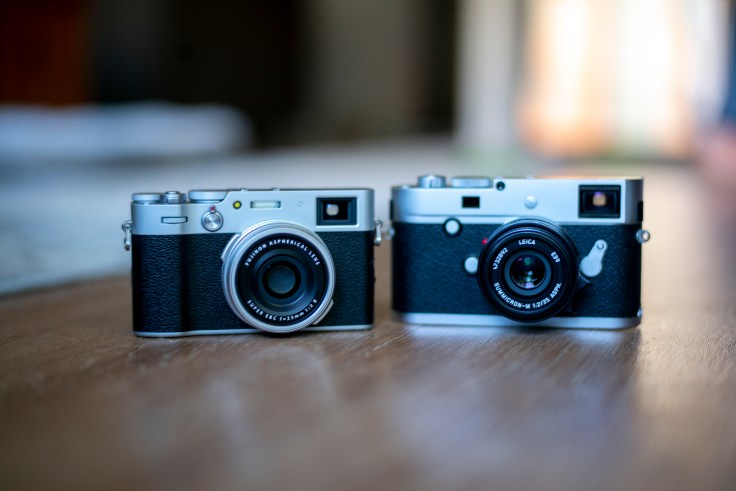
Before unpacking this informal comparison, let me explain myself. “Why compare the Fuji X100v to a digital Leica M & 35mm Summicron ASPH?” some might be asking. I’ll briefly outline my motivations behind this write-up:
First, there is a viewpoint in the photographic community that a crop sensor can become equal to a full frame sensor simply by changing a lens’ focal length and/or aperture. Or, put differently, the 23mm f/2 lens found on the Fuji X100v is marketed as being equal to a 35mm f/2.8 on a full-frame camera.
Second, the Fuji X100v is described by many to be either a rangefinder or rangefinder-like camera. Indeed, many popular and authoritative photography websites have made this claim.
Admittedly, both of these points are trivial. Yet, I am bothered by their persistence when it comes to talking about the X100v and crop sensors in general. Essentially, my motivation behind this write-up is to show that the X100v is not the same as a Leica M, both in terms of functionality and optics.
The X100v looks like a Leica, and I’m certain that was no mistake on Fuji’s part. My feeling is the Fuji X100v was was created to look and “feel” like a Leica. Ironically, when out in public, I’ve had many people ask “Is that a Fuji camera?” with admiration while pointing at the Leica M around my neck. When I say, “No, it’s a Leica,” they either quickly lose interest or aren’t quite sure what a Leica is.
Anyway… to be blunt, I wanted to see how the Fuji X100v compared against the “real deal” of a Leica digital M rangefinder. In addition, I wanted to highlight some examples of why these two photography tools are worlds apart from another; just because the X100v looks like a rangefinder does not mean it is one.
For this write-up, I am using the Leica M-P 240 since that is the Leica body I currently use. As newer Leica bodies are released, such as the M11, the lines behind the X100 line and Leica digital M will undoubtedly blur for some.
Layout, Size and Philosophy
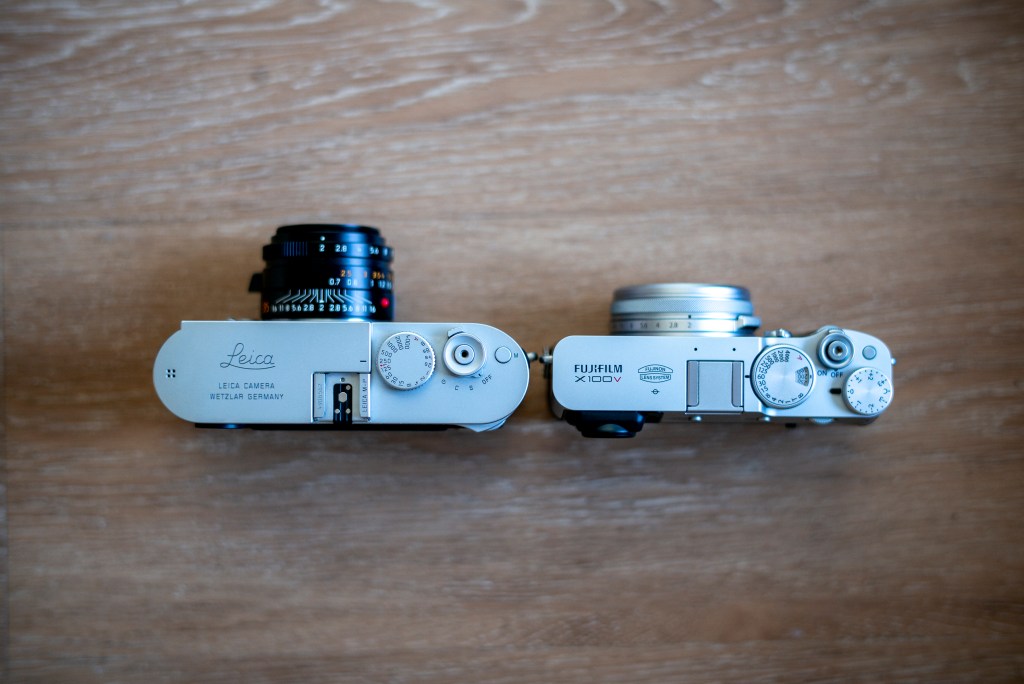
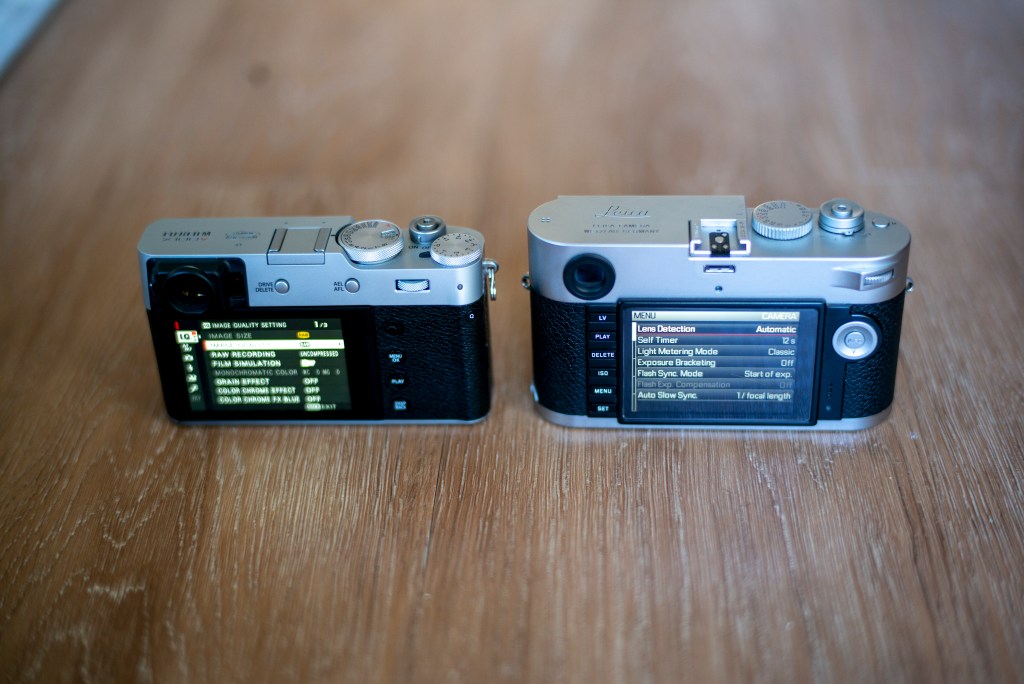
On the surface, the layout and appearance of both cameras are similar. They both have a shutter dial on top, an optical viewfinder, similar number of buttons on the back, similar shutter button placement and such. Going just by appearance, they have a lot in common. It is my opinion that this is what makes the X100v (and other Fujis) so popular: they look cool. Retro. Vintage. Yadda yadda. However, they are completely different beasts – if you’re proficient with one, there will be a steep learning curve in using the other. Indeed, the philosophy behind each camera is very different.
Take the shutter speed dial. To set the shutter speed on the M-P 240 (and other digital Lecia M cameras), you have to use that dial. That’s it. On the X100v, one could potentially change the shutter speed with the dedicated dial on the top or the custom dial on the back. A minor difference, admittedly, but a difference nonetheless. Additionally, the X100v has different shutter types: electronic and mechanical. Changing the type of shutter allows one to shoot at a very fast shutter speed, all the way up to 1/32000 when using an electronic shutter. That’s an impressively fast shutter speed, yes, but it’s not a real shutter doing the work. It’s an electronic shutter. Plus, to take advantage of this high shutter speed, one needs to dive into the menu (a common theme with the X100v).
Additionally, what one sees in the viewfinder of each camera is very different. I’m not talking about the framelines or anything like that (not yet at least). Rather, I’m talking about the data illuminated in the viewfinder. The information displayed in a Leica digital M consists of basically the metering information (shutter speed or light meter) and that’s about it. The X100v has a whole gamut of information such as the battery life, memory card capacity, shutter speed, aperture, white balance, drive setting, image quality settings, and on and on and on. Personally, this is way too much information and another example of how the philosophy of these two cameras is so different.
Rangefinder and Shooting Experience
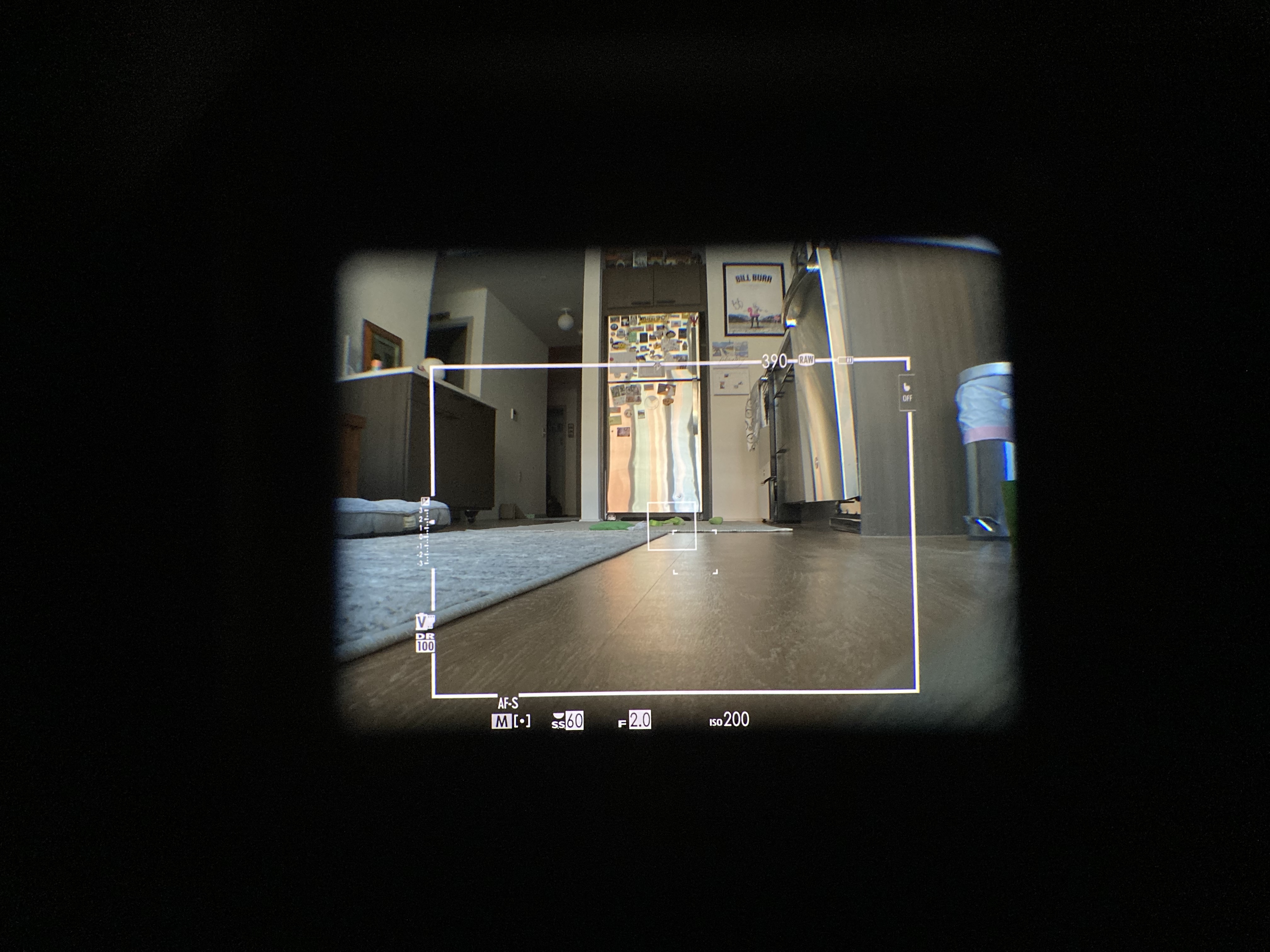
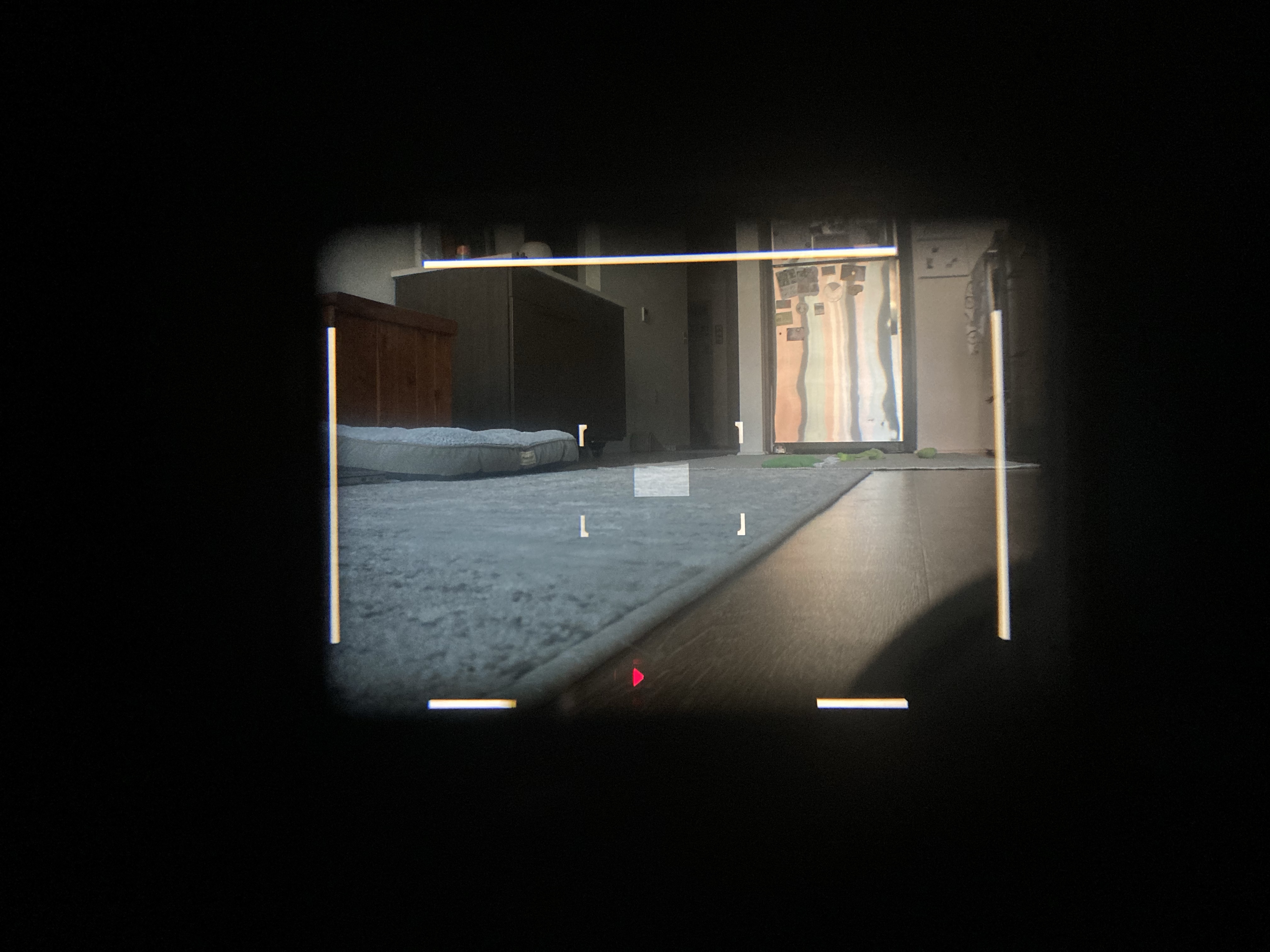
As mentioned, many photography websites (well-known ones, at that) describe the X100v as a rangefinder or rangefinder-like. My response to that statement is simply this: the X100v is not a rangefinder camera. Nor is it similar to one. Break out the fainting couches, I know…
The two images above show the optical viewfinders of an X100v and a typical digital Leica M (M-P 240 in this case). Sure, there are some visual similarities, like the white box which frames what is in the lens’ FOV. While Fuji has done a good job of mimicking a Leica rangefinder with the addition of framelines in the OVF, in practice the framelines are very different.
To begin with, the framelines on the X100v are very small compared what’s seen in the rest of optical viewfinder. To me, this makes composing an image very tedious since the lens’ FOV is crammed into proportionally very small framelines. So much of the viewfinder is wasted. The 35mm framelines on the M-P 240, on the other hand, are much larger compared to the rest of the viewfinder and gives more room to breath when composing a shot. Additionally, I found the framelines of the X100v to be slightly less accurate than the M-P 240. In other words, the final image file of the X100v didn’t match what the framelines were telling me should be in the image. The Leica framelines generally are always very close and predictible.
Anyway, back to the rangefinder aspect. See the small white-ish box in the middle of the M-P 240 viewfinder? That’s the rangefinder patch, and when the overlapping split image aligns that means the subject is in focus. Although seemingly archaic, with practice, it’s very quick and accurate (assuming everything is calibrated correctly).
The X100v does not use this mechanical focusing method, but rather it uses a digital rangefinder-like patch to tell the user the subject is in focus. When using autofocus, I have to trust that when the green “rangefinder patch” illuminates, the camera actually focused on my subject. There is no overlapping split image like a true rangefinder, and I’m relying on the camera to have actually focused on what I wanted. Sure, I can switch to manual focus and quickly zoom in, or flip a switch and get a quick look at the EVF or rear LCD, but this makes using the camera burdensome (for me). I’m spending more time thinking about using the camera than taking a photograph.
Sensor Size: Focal Length, Aperture, and Bokeh
The “35mm equivalent” talking point has been around for a while. It seems to be such a commonly accepted talking point, even B & H lists the “full frame equivalent” focal length of a crop-sensor lens in the technical data, rather than a lens’ real focal length. To be fair, I understand the intention behind this talking point. Full frame lenses produce different images on a crop-sensor when compared to a full-frame sensor. The image is, quite literally, cropped due to the smaller sensor. A 24mm isn’t as wide as it should be, nor is a 35mm, so on and so forth. Therefore, a convenient 1.5x or 1.3x formula gives photographers an idea of how lenses would look on smaller digital sensors.
So where am I going with all this? Well, to be blunt, the 23mm f/2 lens found on a Fuji X100v does not equal a Leica 35mm f/2 Summicron ASPH mounted to a full frame digital Leica M. These two lenses are different, in many ways. First, 23mm is wider than 35mm, and cropping does not change this. Images might look similar side-by-side due to the crop factor, but the lens are optically different. Things like compression and distortion are unique to a lens’ focal length, so there will be minor differences between 23mm and 35mm lenses. Second, f/2 on a crop-sensor camera does not equal f/2.8 on a full-frame camera. The common misconception behind f/2 being equal to f/2.8 revolves around apparent bokeh similarities, with the commonly held belief being f/2 on a crop-sensor produces the same background blur as f/2.8 on a full-frame. This is flase. More importantly, f/2 and f/2.8 literally have different light gathering properties; f/2.8 is full stop slower than f/2.






Colors and IQ (Briefly)
I don’t particularly enjoy comparing image IQ and sensor capabilities, to be honest. Nor was this really a concern of mine. Still, I wanted to see the differences to satisfy my own curiosity.
Nearly all digital cameras I’ve used in the past 5-10 years are more than capable of producing nice files for my shooting style; I rarely shoot above 1600 ISO and try my hardest to get exposure right in the camera. With that said, I wanted to quickly see how the X100v files looked compared to my “old” M-P 240. I’ve provided a few examples below. Honestly, I like the color skin tones of the X100v more, but prefer the M-P 240 for black and white.


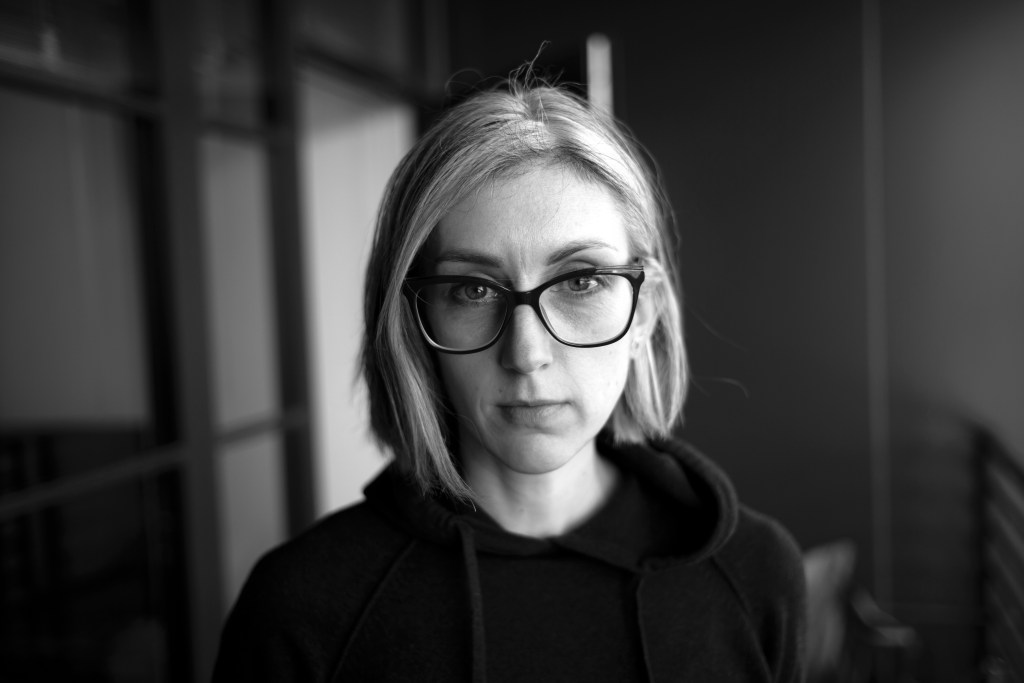

Summary
Ultimately, none of this really matters. Photography is a very personal experience, and personal preferences vary quite a bit. Some folks prefer to shoot with DSLRs, while others prefer mirrorless cameras. Some don’t mind a crop-sensor, others do. Some have brand loyalty to Fuji or Leica, while others prefer Nikon or Canon.
My intent of this write-up was not to admonish Fuji users or elevate Leica shooters. Just because I don’t enjoy shooting with the X100v doesn’t mean its many fans should convert to Leica. On the contrary, “to each their own” as the saying goes. Rather, my goal was to strip back what I view as misguided talking points behind the X100v.
As revolutionary and cool as the X100v is, it does not mimic shooting with a digital Leica M. As demonstrated above, there are mechanical and philosophical differences between these two cameras. Digital Leica M cameras are 100% manual focus and use rangefinder technology from the early 20th Century. Sure, some M cameras have live-view or can accept a mountable EVF, but it’s still manual focus all the way. On the other hand, the X100v has an array of focusing techniques, such as autofocus squares overlaid on the OVF, the option to activate an EVF, and magnification factors for fine-tune focusing. The focusing philosophy behind the X100v is more of a “jack of all trades” approach while the digital Leica M is more of a “master of one approach.” When focusing with a Leica M, I don’t really have to think about how to get the shot in focus or fiddle with buttons/dials/switches to implement different focusing techniques. There’s one way to focus and that’s it, which translates into a richer photographic experience.
Speaking of a richer photographic experience, the limited features found on a Leica M forces me to just use my camera instead of diving into a menu and sorting through countless features and customization options. The X100v has more buttons and dials, and honestly they get in the way rather than serving any purpose for my photography style. Again, this fits the “jack of all trades” approach behind Fuji’s philosophy. Highly customizable cameras and in-depth menus can help a camera be accessible to many different kinds of users, but doing so effectively means the camera suffers from bloat-ware and akin to using a computer with pre-loaded software that I’ll never use.
Additionally, attaching a 35mm f/2 lens to a full frame digital Leica M gives me more creative possibilities than a 23mm f/2 permanently attached to a crop-sensor. I can create more background blur when needed, such as portrait work, for example. Plus, there the benefit of being able to change lenses on a Leica digital M.
Collectively, these differences highlight how unique these cameras are rather illustrating their differences. At the end of the day, they’re both more than capable of creating beautiful images. Pick your poison, and get out there and shoot!

